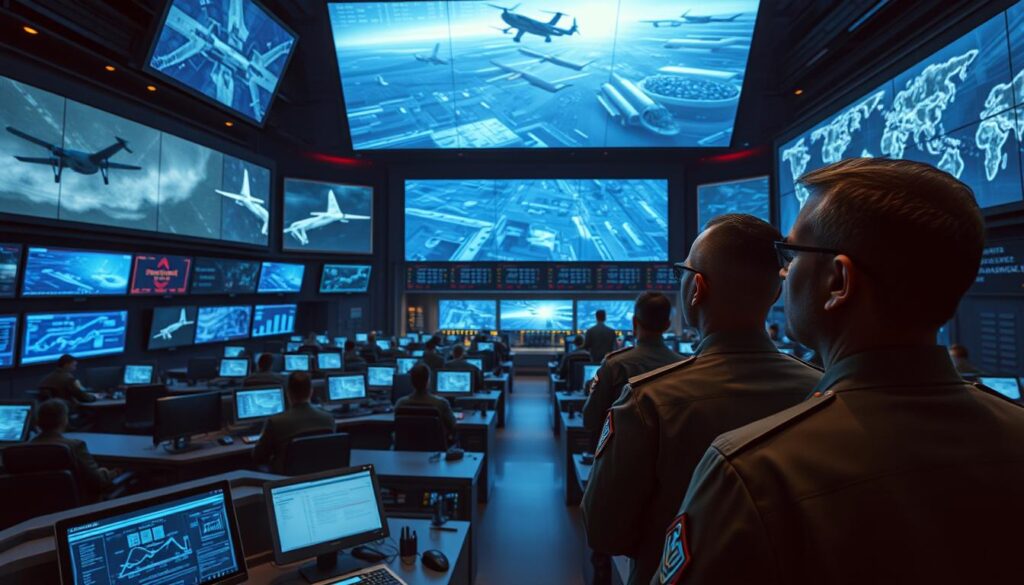“The future belongs to those who prepare for it today.” – Malcolm X. This quote resonates deeply as we explore the dynamic landscape of artificial intelligence (AI) in China. The country has made significant strides in AI, but it faces hurdles that could shape its trajectory in the coming years.
China’s AI ecosystem is thriving, with over 180 large language models approved for general use as of August 20241. However, experts estimate that China’s AI model development lags behind the United States by six to twenty-four months1. This gap highlights the intense competition between the two nations in the tech frontier.
Recent US export controls on semiconductors have further complicated China’s access to advanced AI technology2. Meanwhile, Beijing has increased national research and development spending by 10% in March 2024, aiming for self-reliance in science and technology1. These efforts underscore the strategic importance of AI in China’s vision to become a global tech powerhouse by 2035.
This article delves into the key challenges, including data constraints, technological gaps, and policy implications. It also examines the military applications of AI and the broader geopolitical context. Understanding these factors is crucial for policymakers and industry leaders navigating the evolving AI landscape.
Key Takeaways
- China’s AI development is six to twenty-four months behind the United States1.
- US export controls on semiconductors impact China’s AI capabilities2.
- Beijing increased R&D spending by 10% in March 2024 to boost self-reliance1.
- China aims to become a global tech powerhouse by 20351.
- Military AI applications face challenges due to centralized command structures2.
China’s AI Landscape Amid Global Rivalry

The race for AI supremacy has intensified, with China striving to close the gap with the United States. The country’s artificial intelligence ecosystem is marked by rapid advancements and strategic investments, but it faces significant hurdles in a highly competitive global arena.
Overview of Current Developments
China’s AI ecosystem is vast, with over 180 large language models approved for general use as of August 20243. However, experts estimate that China’s AI model development lags behind the United States by six to twenty-four months3. This gap highlights the intense competition between the two nations in the tech frontier.
Recent US export controls on semiconductors have further complicated China’s access to advanced AI technology4. Despite these challenges, Beijing has increased national research and development spending by 10% in March 2024, aiming for self-reliance in science and technology3.
Comparative Global Perspectives
China’s approach to AI development differs significantly from the United States. While the US relies on concentrated efforts led by companies like OpenAI, Meta, and Google, China boasts an extensive network of AI firms. This decentralized model fosters innovation but also presents challenges in resource allocation and standardization.
The US controls 90% of global semiconductor manufacturing, a critical component for AI chip production4. China’s semiconductor output fell by 17% in 2023 due to export controls on critical technologies from the West4. This has forced Chinese firms to innovate without access to the latest chips, showcasing a shift in the operational landscape for AI development3.
Domestic policies, such as the “Eastern Data, Western Computing” project, aim to accelerate the construction of a national integrated computing power network3. This strategic approach reflects China’s commitment to overcoming technological barriers and achieving self-reliance.
For more insights into how AI is transforming industries, explore AI in finance.
What Are the Challenges Facing China’s AI Development?

China’s journey in artificial intelligence faces hurdles despite its rapid progress. Experts estimate that the country’s AI model development lags behind the United States by six to twenty-four months5. This delay highlights the intense competition in the global tech arena.
One major concern is the aggregation and optimal use of data and computational resources. While China has made strides in AI applications, fragmented investments and regulatory pressures complicate progress6. These organizational hurdles slow down innovation and efficiency.
Kai-Fu Lee, a prominent AI expert, has noted that China’s approach to AI development differs significantly from the United States. He emphasizes the need for a more cohesive strategy to bridge the gap5. This sentiment is echoed in recent policy debates, where scholars advocate for a shift towards biologically inspired AI and new cognitive paradigms6.
Below is a comparative analysis of key factors affecting AI development in China and the United States:
| Factor | China | United States |
|---|---|---|
| Model Development | 6-24 months behind | Leading |
| Data Aggregation | Fragmented | Centralized |
| Investment Landscape | Decentralized | Concentrated |
| Regulatory Environment | Stringent | Flexible |
China’s government has prioritized AI as a strategic area, increasing research and development spending by 10% in March 20245. However, achieving self-reliance in technology remains a significant challenge. For more insights into how AI is transforming industries, explore AI advancements.
As we delve deeper, the next sections will explore technical gaps, organizational hurdles, and regulatory implications. These factors collectively shape the future of artificial intelligence in China.
Technological Gaps and Data Constraints

China’s push for artificial intelligence dominance is met with significant technical and data hurdles. Despite rapid progress, the country faces challenges in hardware and data management that could slow its innovation in this critical technology frontier.
Advanced Hardware Limitations
One of the most pressing issues is the lack of access to cutting-edge semiconductors. US export controls have restricted China’s ability to acquire advanced chips like NVIDIA’s A100, forcing reliance on domestically produced alternatives such as Huawei’s Ascend 910B6. These chips, while functional, lag in performance, creating inefficiencies in AI training and inference processes7.
Industry research highlights rising costs and scalability issues due to these hardware constraints. Without access to the latest technology, Chinese developers face delays in achieving competitive performance in AI model development6.
Data Privacy Concerns
Data acquisition and processing present another major challenge. Large language models require vast amounts of training data, which is often fragmented and difficult to aggregate in China6. Additionally, mounting concerns about data privacy and regulatory oversight complicate the use of such data7.
Critics argue that simply increasing the scale of current models will not achieve true intelligence, calling for new paradigms rooted in cognitive science6. This shift in approach could address some of the systemic issues but requires significant resource allocation and time7.
For more insights into how AI is transforming industries, explore AI and robotics.
Organizational and Ecosystem Hurdles

China’s AI investment landscape is marked by fragmentation and inefficiency. Despite significant contributions from tech giants like Alibaba and Tencent, the ecosystem struggles with a lack of coordination. This decentralized approach has led to diluted resources and slow progress in key areas8.
Fragmented Investment Landscape
The AI startup field in China is crowded, with over 50 companies developing large language models8. While this fosters competition, it also results in inefficient resource allocation. Investments are spread thin, making it difficult for any single entity to achieve breakthroughs. This fragmentation is a major concern for long-term development.
Large players like Baidu and Alibaba have stepped in, but their efforts are often siloed. For example, Baidu’s ERNIE Bot has attracted 200 million users, while Alibaba’s Qwen model is used by 90,000 enterprises8. Despite these successes, the lack of a unified strategy hampers overall progress.
Industry Consolidation Risks
The current funding environment raises the risk of industry consolidation. With venture capital confidence low, smaller startups may struggle to survive. This could lead to a market dominated by a few large companies, stifling innovation and reducing diversity in the ecosystem8.
Experts recommend more strategic and coordinated investments to address these challenges. A cohesive approach could improve resource allocation and accelerate development. Policymakers also play a crucial role in creating an environment that supports growth while mitigating risks8.
Without these changes, China’s ability to compete globally in AI may be compromised. The fragmented ecosystem not only slows progress but also limits the country’s potential to lead in this critical technology frontier.
Policy, Regulation, and Security Implications

China’s AI sector faces a dual challenge: navigating external tech sanctions and internal regulatory hurdles. These factors shape the country’s ability to compete globally in artificial intelligence. The interplay between international restrictions and domestic oversight creates a complex landscape for innovation.
US Export Controls and Tech Sanctions
The United States has implemented stringent export controls on advanced semiconductors, limiting China’s access to critical hardware for AI development9. These sanctions target key technologies like NVIDIA’s A100 chips, forcing Chinese firms to rely on domestically produced alternatives such as Huawei’s Ascend 910B9. This reliance on less advanced hardware slows progress and increases costs.
Experts highlight that these restrictions not only impede China’s AI capabilities but also disrupt global supply chains9. The ongoing technological rivalry between the two nations underscores the strategic importance of semiconductor independence for China’s long-term development.
Domestic Oversight Challenges
Internally, China’s regulatory environment poses its own set of challenges. The government’s “Interim Measures for the Management of Generative Artificial Intelligence Services” aims to ensure AI safety but also introduces stringent censorship standards9. These regulations can stifle innovation by limiting the scope of AI applications and outputs.
Industry leaders argue that balancing safety with openness is crucial for fostering a dynamic AI ecosystem7. Streamlining regulatory oversight while maintaining security remains a top priority for policymakers.
For more insights into the broader implications of these challenges, explore China’s AI strengths and weaknesses.
Military and Strategic Implications of AI

Military applications of artificial intelligence are reshaping global defense strategies, with China at the forefront of this transformation. The integration of AI into military operations has led to significant advancements in Intelligence, Surveillance, and Reconnaissance (ISR) capabilities10. However, the centralized command structure of the People’s Liberation Army (PLA) presents unique challenges in leveraging this technology effectively.
Challenges in PLA Decision-Making
The PLA’s “nanny command style” often results in bureaucratic delays and micro-management by senior commanders. This centralized approach contrasts sharply with the decentralized decision-making enabled by AI, which requires agility and adaptability10. Experts argue that this rigidity could hinder the PLA’s ability to respond dynamically to modern battlefield scenarios.
Chinese defense publications have raised concerns about the over-reliance on hierarchical structures, which may limit the potential of AI-driven systems10. The debate continues on whether AI can truly overcome traditional military hierarchies and introduce a more flexible strategy.
Impact on Battlefield Strategy
AI’s role in enhancing operational efficiency is undeniable. Automated Command and Control (C2) systems allow human operators to focus on strategic decision-making, reducing response times and improving accuracy10. However, the inherent risks of decentralized decision-making, such as unintended escalation, remain a significant concern.
In contrast, the U.S. military’s agile approach to AI integration highlights the advantages of a more flexible system. This disparity underscores the strategic implications for future conflict scenarios, particularly in contested regions like the South China Sea10.
| Aspect | China | United States |
|---|---|---|
| Command Structure | Centralized | Decentralized |
| Decision-Making | Bureaucratic | Agile |
| AI Integration | Hierarchical | Flexible |
| Strategic Risk | Escalation Concerns | Dynamic Adaptation |
As AI continues to evolve, its role in military operations will likely redefine global security dynamics. The PLA’s ability to adapt to these changes will determine its effectiveness in future conflicts10.
Evolving Focus on AI Safety and Research
As artificial intelligence continues to evolve, China has intensified its focus on safety and research to address emerging risks. The country’s scientific and policy communities are increasingly prioritizing development protocols to mitigate potential hazards. This shift reflects a growing recognition of the need for robust safety measures in the AI frontier.
Advancing Safety Protocols
In July 2024, the Chinese Communist Party (CCP) released a major policy document advocating for the establishment of oversight systems to ensure AI safety11. This initiative aligns with the Global AI Governance Initiative introduced by Xi Jinping in October 2023, which emphasized the principle of “ensuring that AI always remains under human control”11. These efforts highlight China’s commitment to creating a secure AI ecosystem.
Technical research has also advanced, with frameworks addressing risks such as bias, discrimination, and adversarial attacks12. The National Technical Committee 260 on Cybersecurity released its AI Safety Governance Framework in September 2024, proposing a tiered management system based on risk levels12. This approach aims to balance innovation with safety.
Academic and Policy Synergies
Collaborations between academia and government bodies are driving progress in AI safety. In June 2023, the Beijing Academy of Artificial Intelligence hosted a forum on frontier AI safety, signaling a growing focus within the technical community11. Prominent figures like Andrew Yao have called for major tech companies to allocate one-third of their R&D budgets to safety research11.
Events like the World AI Conference (WAIC) in July 2024 have further emphasized the need for AI safety as a global public good11. These discussions are shaping policy debates and influencing regulatory measures, ensuring that safety remains a top priority.
Global Safety Collaboration
China is actively participating in international efforts to manage AI risks. In May 2024, Zhipu AI became the first Chinese company to sign the Frontier AI Safety Commitments at the AI Seoul Summit11. This move underscores the importance of cross-border collaboration in addressing shared challenges.
The CCP’s Third Plenary Document in late 2024 called for the establishment of an AI safety supervision and regulation system, linking it to national security risks11. By aligning with global norms and standards, China aims to lead in AI governance while fostering innovation.
For more insights into how AI is transforming education, explore AI in education.
Emerging Applications in Manufacturing, Robotics, and Biotechnology
China is leveraging artificial intelligence to revolutionize industries like manufacturing, robotics, and biotechnology. These sectors are witnessing unprecedented innovation, driven by the need to address demographic shifts and enhance industrial efficiency13.
In manufacturing, AI is being integrated to streamline production processes and reduce costs. Advanced robotics are compensating for a shrinking workforce, with China deploying over 943,000 industrial robots in 2023 alone14. This shift is transforming the industry, making it more competitive on the global stage.
Innovative Industrial Strategies
Government initiatives are playing a pivotal role in this transformation. Programs like “Made in China 2025” focus on upgrading the manufacturing sector through AI and automation13. These efforts are part of a broader strategy to position China as a leader in advanced technologies.
In biotechnology, AI is accelerating medical research and drug discovery. Chinese firms are using machine learning to analyze vast datasets, leading to breakthroughs in personalized medicine14. This progress is supported by significant investments in research and development.
China’s robotics adoption is another area of focus. The country accounts for nearly 40% of global robotics installations, driven by the need to maintain productivity amid labor shortages13. This trend is reshaping the market, with Chinese companies leading in both production and application.
Looking ahead, these emerging applications are expected to have a profound economic impact. By integrating AI into key sectors, China is not only addressing immediate challenges but also laying the groundwork for future development. For more insights into how AI is transforming industries, explore AI tools.
Conclusion
Navigating the complexities of technological advancement, China’s path to AI leadership is fraught with multifaceted hurdles. From hardware limitations to fragmented investments, the country faces significant challenges in achieving its ambitious goals15. US export controls on semiconductors have further strained resources, forcing reliance on domestic alternatives9.
Policy and regulatory frameworks, such as the Interim Measures for Generative AI Service Management, aim to balance innovation with safety15. However, stringent oversight may stifle creativity. The need for robust research and international collaboration is more urgent than ever to address global security risks9.
Emerging applications in manufacturing and biotechnology highlight the transformative potential of AI15. Yet, without coordinated strategy and investment, progress may remain uneven. Policymakers and industry leaders must prioritize innovation while fostering dialogue to navigate this dynamic frontier.
In conclusion, China’s AI journey underscores the importance of addressing technological, organizational, and policy challenges. By advancing research and fostering global partnerships, the country can rebalance the AI landscape and drive meaningful progress.
FAQ
How does China’s AI development compare globally?
What are the key technological gaps in China’s AI sector?
How does the fragmented investment landscape affect China’s AI growth?
What role do US export controls play in China’s AI development?
How is AI influencing China’s military strategy?
What steps is China taking to enhance AI safety?
How is AI being applied in China’s manufacturing and robotics sectors?
Source Links
- Assessing China’s AI development and forecasting its future tech priorities
- The Obstacles to China’s AI Power
- China’s AI development model in an era of technological deglobalization
- China’s AI Ambitions: A Global Race for Supremacy
- AI for the people? How China’s AI development challenges US big tech – Friends of Socialist China
- China Challenges Large Language Models as the Sole Path to General AI
- China banks on open source in AI cold war with US
- China’s Generative AI Ecosystem in 2024: Rising Investment and Expectations
- China And AI In 2025: What Global Executives Must Know To Stay Ahead
- Strategic Implications of AI-Driven Military Operations – CENJOWS
- China’s Views on AI Safety Are Changing—Quickly
- China-releases-AI-safety-governance-framework | DLA Piper
- China Is Rapidly Becoming a Leading Innovator in Advanced Industries
- How Innovative Is China in AI?
- China’s AI Policy & Development: What You Need to Know







